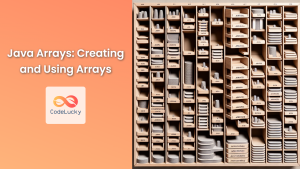Java's Stream API, introduced in Java 8, revolutionized the way developers handle collections and process data. This powerful feature brings functional programming concepts to Java, allowing for more concise, readable, and efficient code. In this comprehensive guide, we'll dive deep into the Stream API, exploring its core concepts, operations, and practical applications.
Understanding Streams
A stream in Java represents a sequence of elements supporting sequential and parallel aggregate operations. Unlike collections, streams don't store data; they convey elements from a source (such as a collection) through a pipeline of computational operations.
🔑 Key characteristics of streams:
- Not a data structure
- Designed for lambdas
- Do not support indexed access
- Can be infinite
- Lazily evaluated
Let's start with a simple example to illustrate the power of streams:
List<String> names = Arrays.asList("Alice", "Bob", "Charlie", "David");
long count = names.stream()
.filter(name -> name.length() > 4)
.count();
System.out.println("Names longer than 4 characters: " + count);
Output:
Names longer than 4 characters: 3
In this example, we create a stream from a list of names, filter out names with more than 4 characters, and count the results. The Stream API makes this operation concise and readable.
Creating Streams
There are several ways to create streams in Java:
- From Collections:
List<Integer> numbers = Arrays.asList(1, 2, 3, 4, 5);
Stream<Integer> stream = numbers.stream();
- From Arrays:
String[] array = {"a", "b", "c"};
Stream<String> stream = Arrays.stream(array);
- Using Stream.of():
Stream<Double> stream = Stream.of(1.1, 2.2, 3.3, 4.4);
- Using Stream.generate() for infinite streams:
Stream<Double> randomNumbers = Stream.generate(Math::random);
- Using Stream.iterate():
Stream<Integer> evenNumbers = Stream.iterate(0, n -> n + 2);
Intermediate Operations
Intermediate operations are lazy and return a new stream. They are only executed when a terminal operation is invoked.
filter()
The filter() operation creates a new stream that includes elements matching a given predicate.
List<String> fruits = Arrays.asList("apple", "banana", "cherry", "date");
fruits.stream()
.filter(fruit -> fruit.startsWith("b"))
.forEach(System.out::println);
Output:
banana
map()
The map() operation transforms each element in the stream using the provided function.
List<String> names = Arrays.asList("Alice", "Bob", "Charlie");
names.stream()
.map(String::toUpperCase)
.forEach(System.out::println);
Output:
ALICE
BOB
CHARLIE
flatMap()
The flatMap() operation is used to flatten nested collections within a stream.
List<List<Integer>> nestedList = Arrays.asList(
Arrays.asList(1, 2, 3),
Arrays.asList(4, 5, 6),
Arrays.asList(7, 8, 9)
);
nestedList.stream()
.flatMap(Collection::stream)
.forEach(System.out::print);
Output:
123456789
distinct()
The distinct() operation removes duplicate elements from the stream.
List<Integer> numbers = Arrays.asList(1, 2, 2, 3, 3, 4, 5, 5);
numbers.stream()
.distinct()
.forEach(System.out::print);
Output:
12345
sorted()
The sorted() operation sorts the elements in the stream.
List<String> fruits = Arrays.asList("banana", "apple", "cherry", "date");
fruits.stream()
.sorted()
.forEach(System.out::println);
Output:
apple
banana
cherry
date
limit() and skip()
The limit() operation restricts the stream to a certain number of elements, while skip() discards the first n elements.
Stream.iterate(1, n -> n + 1)
.skip(5)
.limit(5)
.forEach(System.out::print);
Output:
678910
Terminal Operations
Terminal operations trigger the execution of the stream pipeline and produce a result or a side-effect.
forEach()
The forEach() operation performs an action for each element in the stream.
List<String> colors = Arrays.asList("red", "green", "blue");
colors.stream()
.forEach(color -> System.out.println("Color: " + color));
Output:
Color: red
Color: green
Color: blue
collect()
The collect() operation accumulates elements into a collection or other result container.
List<String> fruits = Arrays.asList("apple", "banana", "cherry", "date");
Set<String> fruitSet = fruits.stream()
.filter(fruit -> fruit.length() > 5)
.collect(Collectors.toSet());
System.out.println(fruitSet);
Output:
[banana, cherry]
reduce()
The reduce() operation combines stream elements into a single result.
List<Integer> numbers = Arrays.asList(1, 2, 3, 4, 5);
int sum = numbers.stream()
.reduce(0, (a, b) -> a + b);
System.out.println("Sum: " + sum);
Output:
Sum: 15
count()
The count() operation returns the number of elements in the stream.
List<String> words = Arrays.asList("hello", "world", "java", "stream");
long count = words.stream()
.filter(word -> word.length() > 4)
.count();
System.out.println("Words longer than 4 characters: " + count);
Output:
Words longer than 4 characters: 3
anyMatch(), allMatch(), and noneMatch()
These operations check if elements in the stream match a given predicate.
List<Integer> numbers = Arrays.asList(1, 2, 3, 4, 5);
boolean anyEven = numbers.stream().anyMatch(n -> n % 2 == 0);
boolean allPositive = numbers.stream().allMatch(n -> n > 0);
boolean noneNegative = numbers.stream().noneMatch(n -> n < 0);
System.out.println("Any even number? " + anyEven);
System.out.println("All positive numbers? " + allPositive);
System.out.println("No negative numbers? " + noneNegative);
Output:
Any even number? true
All positive numbers? true
No negative numbers? true
Advanced Stream Operations
Parallel Streams
Parallel streams can significantly improve performance for large datasets by utilizing multiple threads.
List<Integer> numbers = Arrays.asList(1, 2, 3, 4, 5, 6, 7, 8, 9, 10);
long sum = numbers.parallelStream()
.reduce(0, Integer::sum);
System.out.println("Sum: " + sum);
Output:
Sum: 55
Custom Collectors
You can create custom collectors for more complex reduction operations.
class Person {
String name;
int age;
Person(String name, int age) {
this.name = name;
this.age = age;
}
}
List<Person> people = Arrays.asList(
new Person("Alice", 25),
new Person("Bob", 30),
new Person("Charlie", 35)
);
Map<Integer, List<String>> peopleByAge = people.stream()
.collect(Collectors.groupingBy(
person -> person.age,
Collectors.mapping(person -> person.name, Collectors.toList())
));
System.out.println(peopleByAge);
Output:
{25=[Alice], 30=[Bob], 35=[Charlie]}
Infinite Streams
Infinite streams can be useful for generating sequences or simulating continuous data sources.
Stream.iterate(0, n -> n + 2)
.limit(5)
.forEach(System.out::println);
Output:
0
2
4
6
8
Best Practices and Performance Considerations
-
🚀 Use parallel streams judiciously: They can improve performance for large datasets, but may introduce overhead for small ones.
-
🔍 Prefer specific stream methods: Use
mapToInt(),mapToLong(), andmapToDouble()for primitive streams to avoid boxing/unboxing overhead. -
🔄 Reuse streams: Streams can't be reused after a terminal operation. Create a supplier if you need to perform multiple operations on the same data.
-
🎯 Use short-circuiting operations: Operations like
findFirst(),findAny(),anyMatch(),allMatch(), andnoneMatch()can improve performance by not processing the entire stream. -
📊 Consider the source: Some sources (like ArrayList) are more efficient for certain operations than others (like LinkedList).
Real-World Example: Analyzing Sales Data
Let's put our Stream API knowledge to use with a practical example. We'll analyze a dataset of sales transactions.
class Sale {
String product;
double amount;
String category;
Sale(String product, double amount, String category) {
this.product = product;
this.amount = amount;
this.category = category;
}
}
List<Sale> sales = Arrays.asList(
new Sale("Laptop", 999.99, "Electronics"),
new Sale("Book", 19.99, "Books"),
new Sale("Smartphone", 599.99, "Electronics"),
new Sale("Headphones", 99.99, "Electronics"),
new Sale("Tablet", 299.99, "Electronics"),
new Sale("Novel", 9.99, "Books")
);
// Calculate total sales
double totalSales = sales.stream()
.mapToDouble(sale -> sale.amount)
.sum();
System.out.println("Total sales: $" + totalSales);
// Find the most expensive product
Sale mostExpensive = sales.stream()
.max(Comparator.comparingDouble(sale -> sale.amount))
.orElseThrow(NoSuchElementException::new);
System.out.println("Most expensive product: " + mostExpensive.product);
// Group sales by category
Map<String, List<Sale>> salesByCategory = sales.stream()
.collect(Collectors.groupingBy(sale -> sale.category));
System.out.println("Sales by category: " + salesByCategory);
// Calculate average sale amount for each category
Map<String, Double> avgSaleByCategory = sales.stream()
.collect(Collectors.groupingBy(
sale -> sale.category,
Collectors.averagingDouble(sale -> sale.amount)
));
System.out.println("Average sale by category: " + avgSaleByCategory);
Output:
Total sales: $2029.94
Most expensive product: Laptop
Sales by category: {Electronics=[Sale@1b6d3586, Sale@4554617c, Sale@74a14482, Sale@1540e19d], Books=[Sale@677327b6, Sale@14ae5a5]}
Average sale by category: {Electronics=499.99, Books=14.99}
This example demonstrates how the Stream API can be used to perform complex data analysis tasks with minimal code. We've calculated total sales, found the most expensive product, grouped sales by category, and calculated average sale amounts per category, all using stream operations.
Conclusion
The Java Stream API is a powerful tool for processing collections of data in a functional style. It offers a wide range of operations that can be combined to create complex data processing pipelines. By leveraging streams, developers can write more concise, readable, and often more efficient code.
Key takeaways:
- 🔹 Streams provide a functional approach to data processing in Java.
- 🔹 They support both sequential and parallel execution.
- 🔹 Streams consist of a source, intermediate operations, and a terminal operation.
- 🔹 Intermediate operations are lazy and only executed when a terminal operation is invoked.
- 🔹 The API offers a rich set of operations for filtering, mapping, reducing, and collecting data.
As you continue to work with the Stream API, you'll discover even more ways to leverage its power in your Java applications. Remember to consider performance implications, especially when working with large datasets or using parallel streams. With practice, you'll be able to write elegant, efficient code that takes full advantage of Java's functional programming capabilities.



















